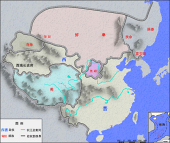How was Jin Dynasty founded? Before the formation of the Jin Dynasty, Sima Yi was a Minister of the Wei State (220-265). He was a brilliant military tactician during the wars against the Shu State (221-263) and the Wu State (220-280). In 239, Wei State Emperor Mingdi died and Sima Yi and Cao Shuang were named as co-leaders of the state's military forces. At the beginning, |  |
the two men engaged in a fierce power struggle. Initially Cao grasped the real power, but Sima Yi would ultimately prevail. Once when Cao and the Wei Emperortraveled to sweep Mingdi's tomb, Sima Yi took over Cao Shuang's compound, his arsenals and blocked access to the city of Luoyang. He then forced the Empress to abolish the official positions of Cao Shuang and his brother. At this point, Sima Yi asked the Emperor to remove Cao Shuang and his brother from power. Seeing no alternative Cao resigned. Shortly after, Cao and many of his colleagues were executed for treason. This put Sima Yi into position to begin his autocratic rule of the Wei State. After Sima Yi's death, his family's forces in the Wei State were gradually consolidated by his sons Sima Shi and Sima Zhao. In 263, Sima Zhao hatched a plan to claim the throne for himself. He ordered his generals Zhong Hui and Deng Ai to attack the Shu State. This effectively drove the Shu State out of existence. Soon after, Sima Zhao died and his son Sima Yan usurped the throne of the Wei State in 265. This marked the establishment of the Jin Dynasty. Sima Yan named himself Emperor Wu and made Luoyang the capital of his empire. |